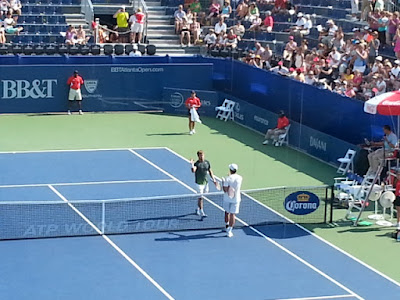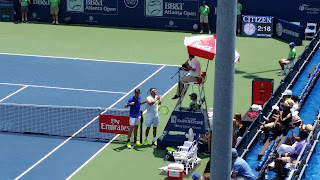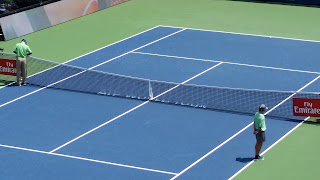As a 20-year-old, Ben Shelton has already made an impact on the men's professional tennis tour - at the ATP and ATP Challenger levels and now on the Grand Slam stage at the 2023 Australian Open - after successes in USTA junior events and in NCAA/ITA college tennis while at the University of Florida, whose men's program is coached by his father, former tour pro Brian Shelton.
My first officiating experience with Ben was at the Rome Tennis Center (in Georgia), where top level junior tournaments are held almost every month of the year, in March of 2018. As a roving official, I was covering several courts simultaneously and my attention was drawn to one that had gotten louder than the others because one of players had shouted (ostensibly at himself) and ejected a ball from the court. That player was 15-year-old Ben Shelton, who I believe was playing in the 18's age level group. Because I didn't personally witness Ben hitting the ball in anger over the fence, I couldn't give him a code violation for ball abuse; however, I did enter the court on the next changeover and 'warn' him that he was lucky not to have received one. I then spent more of my remaining shift monitoring his match.
In August of 2019, I was working at the Boys Nationals in Kalamazoo, Michigan ("Nats at the Zoo") as a line umpire on the last weekend of the event and witnessed Ben's matches in the 16's: he lost in the semifinal and then in the 3rd place match as well.
The last junior level encounter that I remember occurred during a rain delay on the final day of a tournament in Augusta, Georgia in September of 2020. The event was all but over except for the last couple of finals in the 18's. As officials, we were in the clubhouse watching football and the U.S. Open (for the past couple of hours) as the time approached 5 PM. Rain delays are the bane of tennis officiating, especially on the last day when everyone wants to get home. The players, on the other hand, want to get their points and their trophies, which they don't get when the finals are cancelled. Enter Ben Shelton and his singles opponent, who were to face off in the doubles as well. Ben proposed a deal whereby his opponent would receive one trophy and he would take the other. The tournament director agreed, and soon thereafter the event was cancelled, and we all got to leave.
In the spring of 2021, Ben won the clinching match as the Florida Gators won the men's NCAA team championship, but my only real memorable encounter on the college courts with Ben was in early 2022 at the University of Georgia indoor facility. During the Dawgs-Gators dual meet, I was the chair umpire for the number one doubles line, which Ben and his partner won. Ben would go on to win the individual men's NCAA title that spring.
Last summer (July of 2022), Ben received a wild card to play in the Atlanta Open ATP 250 event, which I've worked since 2019, and won his first tour level event. In his second match, he almost defeated the defending champ and six-time winner John Isner in a 2 and a half hour three-set night thriller, but came up just short 6-7(8), 6-4, 6-7(3).
I have enjoyed officiating tennis and one of the best parts is getting to see players early in the careers, not knowing who will succeed at the top levels etc. Speaking of the Australian Open, I got to participate in several of Sofia Kenin's ITF matches in Dothan, Alabama before she was successful on the WTA tour and went on to win the women's title down under in 2020. One of these days, I'm going to have to go back and write down all of the professional tennis players that I've had the pleasure to officiate.






































